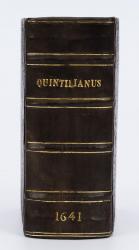Quintilian [Marcus Fabius Quintilianus]. M. Fabii Quintiliani Institutionum Orat
M. Fabii Quintiliani Institutionum Oratoriarum Libri duodecim, Summa diligentia ad fidem vetustissimorum codicum recogniti, ac restituti. Novae huic Editioni adiecit Fabianarum Notarum Spicilegium Subcisivum Daniel Pareus Phil. Fil. Accesserum etiam Quintilianorum Declamationes. Cum Indice accuratissime.
Two Volumes (Parts) in One Volume (complete). London, Typis E.G. Impensis R. Whitakeri [Richard Whitaker], 1641. Octavo. Pagination: Part I: Titlepage, 722 pages plus 58 unnumbered pages of an Index / Part II [Eloquent Declamations]: 569 pages plus 6 unnumbered pages of an Index. Hardcover / Original 17th century boards with modern spine bound to style of the 17th century. New endpapers. Very good condition with some signs of external wear.
Marcus Fabius Quintilianus (Latin: c. 35 – c. 100 AD) was a Roman educator and rhetorician born in Hispania, widely referred to in medieval schools of rhetoric and in Renaissance writing. In English translation, he is usually referred to as Quintilian, although the alternate spellings of Quintillian and Quinctilian are occasionally seen, the latter in older texts.
The only extant work of Quintilian is a twelve-volume textbook on rhetoric entitled Institutio Oratoria (generally referred to in English as the Institutes of Oratory), written around 95 AD. This work deals not only with the theory and practice of rhetoric, but also with the foundational education and development of the orator himself, providing advice that ran from the cradle to the grave. An earlier text, De Causis Corruptae Eloquentiae (″On the Causes of Corrupted Eloquence”) has been lost, but is believed to have been “a preliminary exposition of some of the views later set forth in [Institutio Oratoria]”.
In addition, there are two sets of declamations, Declamationes Maiores and Declamationes Minores, which have been attributed to Quintilian. However, there is some dispute over the real writer of these texts: “Some modern scholars believe that the declamations circulated in his name represent the lecture notes of a scholar either using Quintilian’s system or actually trained by him”.
Institutio Oratoria (English: Institutes of Oratory) is a twelve-volume textbook on the theory and practice of rhetoric by Roman rhetorician Quintilian. It was written around year 95 AD. The work deals also with the foundational education and development of the orator himself. In this work, Quintilian establishes that the perfect orator is first a good man, and after that he is a good speaker. He also believed that a speech should stay genuine to a message that is “just and honorable”. This came to be known as his good man theory, embracing the message that if one cannot be genuinely good, then one cannot be a good speaker for the people. This theory also revolves around being of service to the people. A good man is one who works for the good of the people and the prosperity of society.
Quintilian wrote Institutio Oratoria in the last years of Domitian’s rule of the Roman Empire. He had worked alongside Domitian, but as he began to write more and ease away from Emperor Domitian’s complete power, the emperor did not seem to mind as he was so impressed with Quintilian, he hired him to be a tutor for his family because of Quintilian’s devotion to education. Domitian was in the harshest period of his rule, and almost no one had the courage to speak any idea that was unlike his, but Quintilian did. He spoke as an orator in the tradition of Cicero, such as had not been seen since the beginning of the reign of Augustus. Rather than pleading cases, as an orator of his era might have been expected to do, he concentrated on speaking in more general terms about how sound rhetoric influences the education of the people.
The influence of Quintilian’s masterwork, Institutio Oratoria, can be felt in several areas. First of all, there is his criticism of the orator Seneca the Younger. Quintilian was attempting to modify the prevailing imperial style of oratory with his book, and Seneca was the principal figure in that style’s tradition. He was more recent than many of the authors mentioned by Quintilian, but his reputation within the post-classical style necessitated both his mention and the criticism or back-handed praise that is given to him. Quintilian believed that “his style is for the most part corrupt and extremely dangerous because it abounds in attractive faults”. Seneca was regarded as doubly dangerous because his style was sometimes attractive. This reading of Seneca “has heavily coloured subsequent judgments of Seneca and his style”. (Wikipedia)
- Keywords: Catalogue No.18 – Classical Literature · Classical Literature – Rare · Classics
- Language: Latin
- Inventory Number: 31411AB
EUR 1.280,--
© 2025 Inanna Rare Books Ltd. | Powered by HESCOM-Software




















